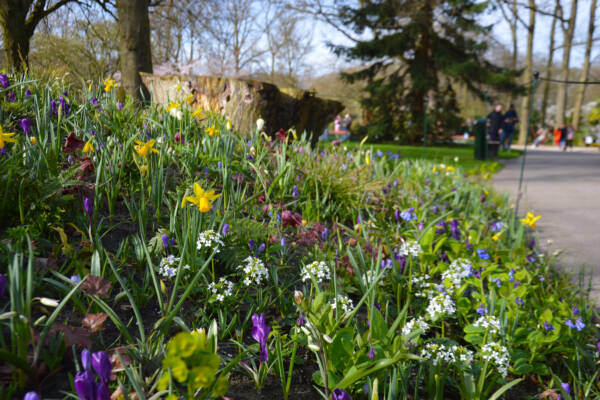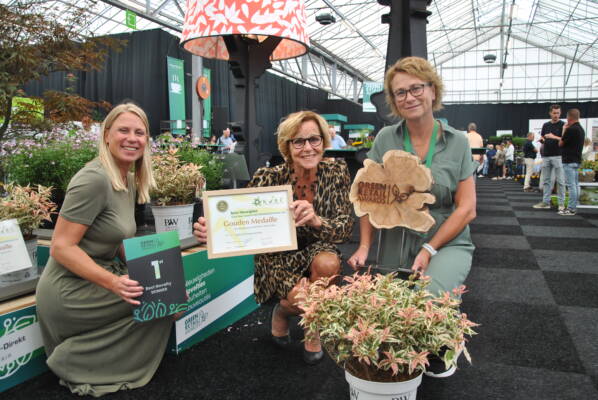Though it may have been slow off the mark — and indeed much slower than many of their members and customer might have liked — it is now quickly dawning upon the world’s largest flower auction that their once exclusive domain is being rapidly disrupted by the internet, decreasing clock sales, direct shipping and globalization: all changing customer habits. FCI sat down with Royal FloraHolland CEO Lucas Vos to get the full story. In this first episode, Vos touches on the auction’s new business strategy, while emphasizing the need for product branding.
Simply put, no longer is it enough for the more than a century old institution to play merely a mediation role, bringing suppliers and buyers together to determine prices. Its physical auction rooms are emptying at a rapid pace, and in today’s highly competitive industry the auction faces increasing pressure to justify its worth in the new-look flower world.
Now is the time where for the auction to evolve into a full service market and meeting place – with the most stable, best possible price at the lowest cost, and well-oiled, efficient logistics – and into an international platform for the exchange of market data and research findings. The groundwork for the Royal FloraHolland Academy is already laid.
Descending the Ivory Tower
Soon after his appointment as the auction’s new CEO on January 1st 2014 it became clear to 48-year old Lucas Vos that he was not a person to make distant observations. He was quick to come down from the Ivory Tower to interact directly with the community to help growers and customers alike manage the new, constantly changing paradigm of worldwide flower trading 2.0.
Since, in spreading his message, Vos takes a pro-active role in marketing the company, using his social talents. He appears in videos on Royal FloraHolland’s YouTube channel, giving a growing group of dedicated followers of his vlogs regular business updates.
Vlogger Vos’ mission for the YouTube channel seems to be clearly stated. In a relaxed, personal style he appears committed to inform, educate and announce who Royal FloraHolland are as a group of people.
Five programmes
Over the past few months, grower members, buyers and auction workers have been regularly updated about the five programmes embedded in RFH’s new business strategy: Improving Together, Consumer, The New Auctioning, WFE, Cooperative 2020 and FLOW.
Not all goes fast enough. More recently, Vos questioned whether the auction’s new business strategy for 2020 moves at a fast enough space to really make a significant difference.
Critical voices say that debate over all the dossiers and programmes is being used to deflect from making real decisions. Vos only partially agrees. He says, “The process is very lengthy indeed, but is also part of what has made us so strong: the voice of our members, including big members and the smaller ones. Actually the smaller ones depend more on us these days than the big ones do. I disagree that the process is being used to deflect from making real decisions. I am trying to find the right balance. First, we need to take people along, but there comes a moment when we need to start making decisions. The first decisions are about the cooperative’s financing. Hopefully we can present a good result at the upcoming GGM in June. The next decision regards the New Auctioning. A flower auction 2.0 which will be dramatically different from what we have today. The good thing about these discussions is that members have now also come so to the conclusion that the way the auction process is carried out today is just not sustainable. It is not modern, and people realise that the physical auction halls will disappear. This doesn’t mean that the clock will automatically disappear, but it will move entirely into the cloud. I feel that my growers are now supporting our ideas. That’s good, and I need to use that momentum.”
‘There is no escape from the dissecting knife’
Job number one
When asked about job number one, the real decisions and their time frame, Vos says that his company most urgently needs to undergo ‘an open heart surgery’. He calls for calm; the situation is not life threatening, but there is no escape from the dissecting knife.
“Currently the auction hosts 38 auction clocks. How will they look in the future, will they purely be located in the cloud, will all three export locations continue to have a clock? All these key questions force us to take a stand this year.”
Something that is at the forefront of most grower’s minds is that transactions are becoming increasingly smaller. Most of them are now below €100, which means that logistical costs per transaction are increasing tremendously. According to Vos this is becoming pretty much of a burden for his growers. Not only in terms of clock business, but also for direct trade flows. “The most pressing issue is that of finding our way back to the consumer, and to really start being effective. We are now all in agreement that we have lost the consumer,” Vos says.
Long term strategic goals
Working on a multitude of programmes with big names sounds impressive, however isn’t there a risk of losing sight of the two long term strategic goals: better margins for member growers and their customers, and a 20 per cent increase in expenditure on cut flowers and plants in Europe? Vos notes, “I repeat these goals nearly every day. It almost feels like a prayer! Better margins for our members and their customers is where the New Auctioning and Flow come in. Speaking of more consumers buying more flowers, there is this group of emerging market consumers. In China for example, the World Flower Exchange programme is progressing quite nicely. Following a series of operational trials, we have now embarked on a number of commercial shipments. In the bigger scheme of things it is still peanuts compared with what we do, with no more than 1500 bouquets being sold. But the lessons we can draw out of these exercises are really big. Our flowers prove popular with Chinese customers, who also discover that we are perfectly able to deliver them to their doorstep. But it is not just about China, we need to start looking at other markets as well.”
Europe
The second group comprises the already existing customer in Europe. For all the market research, the big data, the in-house expertise and the actions being undertaken in different sales channels – florists, retail markets or new e-tailers – the auction has not yet found the right direction. But sitting back and relaxing is no option for the auction’s CEO. “We have teamed up with FlowerFactor owned by Dutch floral arranger Pim van den Akker, who runs a programme for 7 to 8-year old children to teach them about the benefits of flowers and plants. Meanwhile, we have jumped on the new urban lifestyle bandwagon by launching letitgrow.org, an online platform that provides an environment purposely designed for (horticultural) entrepreneurs, artists, companies and consumers. It concentrates on actions Royal FloraHolland can take to help build healthy, sustainable and liveable cities. All these initiatives require funding and because they are new they also bring along a certain amount of risk.”
The fact that the auction’s customers greenlighted the joint funding (production and trade) of floral promotion last year is a step into the right direction. But no more than that. “Because €14 million is really not enough money to make the difference. What it really boils down to is branding. Consumers have many retail and product options at their fingertips, but the choice is limited or none if they are looking for a specific trustworthy brand that conjures up images of long shelf life and eco-friendliness. Here the industry is to blame for having created indifference among consumers; much to the misfortune of my growers and their customers because there is much value in a good brand.”
Initially, when Vos entered this industry he was concerned that growing margins for his members would be to the detriment of the customers. But things turned out differently. “I soon discovered that a powerful brand allows my customers to add extra margins to their products. Actually they can go perfectly hand in hand.”
Vos ponders over the fact that in a country famed for its flowers, the initiatives in the field of Holland branding are so limited. “Pretty weird isn’t it? Despite the fact that the level of cooperation between my growers and customers is pretty high, they haven’t been able to translate this into an all-compassing Holland brand that every consumer recognizes.”
Vos emphasized that all this doesn’t mean that Royal FloraHolland is working on its own brand.
‘The industry is to blame for having created indifference among consumers’
As part of the Royal FloraHolland 2020 strategy, Royal FloraHolland is relinquishing, as far as possible, activities conducted after the moment of purchase to the market. As such, the auction decided to withdraw from consumer brand Frederique’s Choice on January 1st 2015. A contradictio in terminis? “Our strategy literally states that we will not make a consumer brand but that doesn’t mean that we not should support growers to do so. The strategy dates back to 2014. I am constantly learning, and it becomes increasingly clear that consumer branding might actually be the field where the key to better margins for growers lies.”
Lean Six Sigma
Over the past two years, Vos has strongly advocated the use of the principles of the Lean Six Sigma; a data-driven method for achieving near perfect quality. Six Sigma analysis can focus on any element of production or service, and has a strong emphasis on statistical analysis in customer-oriented activities. But statistically evaluating the impact of promotion is a daunting task. “It is indeed and this is exactly what we haven’t been able to do. In the current situation, you have free riders; economic actors who avoid paying for public services. Our general response to this is: make it more our task, it’s our ambition to ensure good floral promotion so the turnover of my growers will grow. Can I guarantee my growers that this free ride will disappear? No, I can’t. Unless we build a typical Dutch brand and actively do something about it. So yes, the data is very difficult to generate if you stay generic, and there is always a sort of a leap of good faith when you do that. A lot of Dutch have grown up with the golden oldie slogan Bloemen houden van mensen (Flowers love people). But does it guarantee that they will buy flowers from my growers? No. This is something Royal FloraHolland can play with. But that’s just a step too far many stakeholders within our industry.”
Promotion strategy 2017
VGB and RFH have teamed up to develop a joint promotion strategy for 2017. Emotion, health and well-being should play a major role in the Flower Council of Holland’s future campaigns. “The key message should be that having flowers and plants is enjoyable. Important to take into account are the trends in the home décor industry and the question of how our products can benefit from these? To top it off, future campaigns should highlight that flowers and plants provide a convenient, hassle-free shopping experience at every stage of the customer journey”, Vos says.
He stresses the importance of teamwork that goes beyond the industry’s own supply chain. “I always use the examples of detergents with floral prints on their packaging. I am quite convinced that either Unilever or Procter and Gambler wouldn’t mind to be associated with Royal FloraHolland. Provided that our flowers are produced in a proper manner.”
Speaking of promotion and the Flower Council of Holland, Vos proposes greater competition as a possible solution to address the challenge of providing solid marketing ideas, while improving quality and controlling costs. “I am very clear that greater competition is needed. The Flower Council of Holland is doing good things, but they play in a competitive field. They need to show us that they are the best way in which we can spend our money. For me it is not a given that it is always the Flower Council who receives the money.”
In the meantime, Vos would be more than happy to move to a more voluntary levy system, including ROI measuring at the per campaign level. “The challenge lies in proving my growers that if they pay me €8 million right now, I am using this amount of money to collect another €8 million elsewhere.”
Vos concludes by saying that he is well aware that auction costs are always considered too high, especially when growers and their customers start adding up everything: membership, promotional levy and logistical means. Even so, the 0.4% levy is not under heavy fire. “But I am well aware that pain is being felt in relation to specific export markets. If today you’re exporting to Russia and you hear that the promotion levy is not used for Russia but for the UK, France and Germany, then things start getting painful.”










































